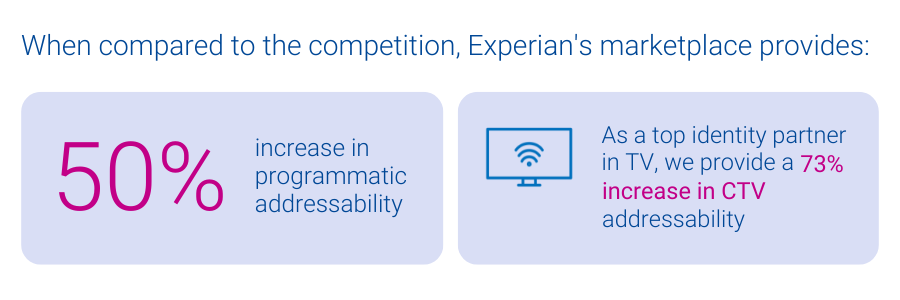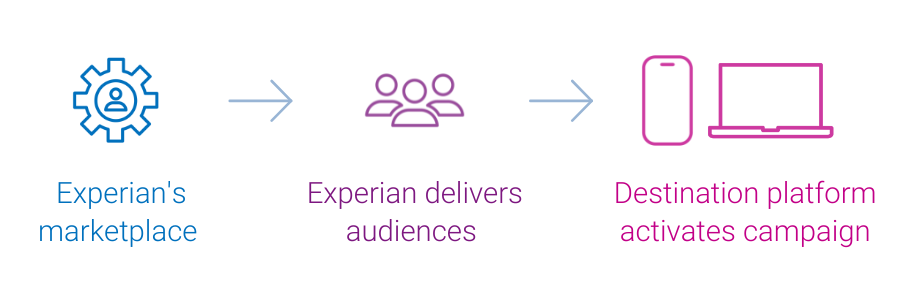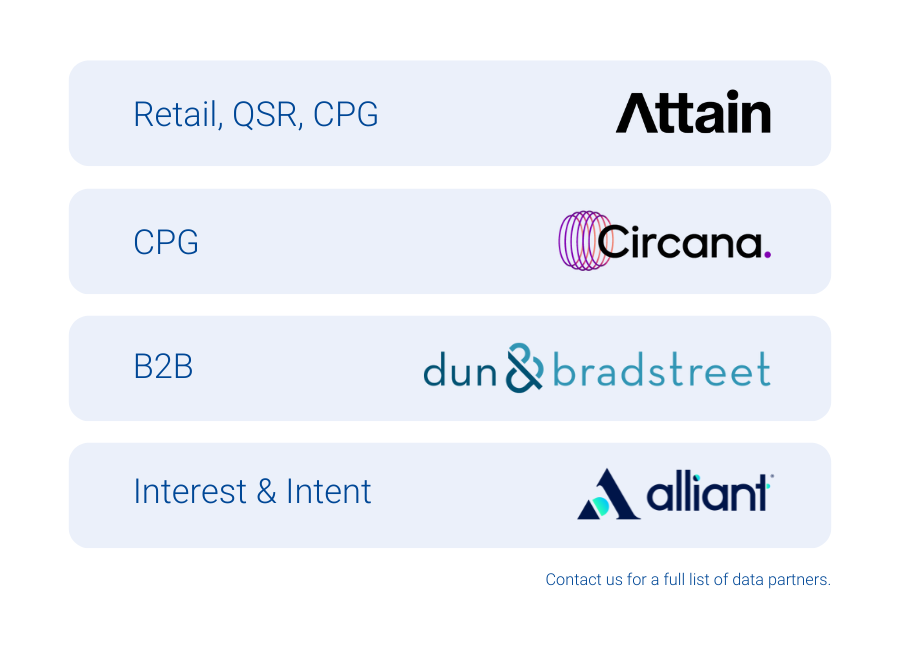
In a perfect world, we’d all have a single, go-to grocery store that carried everything on our shopping list – fresh produce, gourmet coffee beans, rare spices, and maybe even that special-grade olive oil, right alongside our wholesale bulk purchases at unbeatable prices. It would be convenient and efficient, and it’d save a lot of driving around town.
The changing data marketplace: From one-stop shop to specialized selection
For a long time, data buyers enjoyed something similar in their world: a small set of large-scale data marketplaces that offered a wide array of audiences, making it easy to load up on whatever you needed in one place. Not only are there fewer places to pick everything up, but new factors like privacy and signal deprecation are placing a spotlight on quality and addressability.
Just as our dinner plans are growing more ambitious insofar as we want health, flavor, value, and convenience all in one place – so are our data strategies. Instead of a single steak-and-potatoes meal, today’s data marketplace operators might be cooking up a complex menu of campaigns.
“Experian has been a longstanding partner of DISH Media, and we’re excited to be an early adopter of their marketplace which leverages the foundation of their identity solutions to ensure maximum cross-channel reach as we look to expand the breadth and depth of data we use for addressable TV.”
Kemal Bokhari, Head of Data, Measurement & Analytics, DISH Media
As a result, data buyers are beginning to shop around. Some still rely on large-scale marketplaces for familiar staples, but now they have reasons to explore other options. Some are turning to providers known for offering top-tier, transparently sourced segments. Others are focusing on specialty providers that excel in one area.
A more selective approach to data buying
In this environment, choosing where to “shop” for data is becoming more deliberate and selective. Data buyers aren’t just thinking about broad scale; they’re looking to prioritize quality, durability, data privacy, and differentiation. They need to place higher value on data marketplaces that can maintain audience addressability over time, despite signal loss. Sometimes, that means accepting a smaller assortment in exchange for tighter vetting and more reliable targeting. Other times it means mixing and matching – stopping by one marketplace for premium segments and another for cost-friendly, wide-reaching data sets. Either way, they can benefit from having more choices.
“Experian has been a longstanding partner of DISH Media, and we’re excited to be an early adopter of their marketplace which leverages the foundation of their identity solutions to ensure maximum cross-channel reach as we look to expand the breadth and depth of data we use for addressable TV.”
Kemal Bokhari, Head of Data, Measurement & Analytics, DISH Media
Experian’s marketplace: A trusted source for high-quality data
Experian’s vetted and curated blend of data partners and vertically-aligned audiences offers a trusted specialty store for data buyers. Experian’s marketplace, powered by identity graphs that include 126 million households, 250 million individuals, and 4 billion active digital IDs, enables partner audiences to be easily activated and maintain high addressability across display, mobile, and connected TV (CTV) channels. In particular, Experian’s marketplace provides:


The future of data marketplaces: Precision and flexibility matter
The evolution of data marketplaces reflects the industry’s shifting priorities. Data buyers seek specificity, reliability, and adaptability to align with their diverse campaign needs. The best data strategy, much like the best grocery run, isn’t about grabbing everything in one place – it’s about carefully selecting the right ingredients to create the perfect recipe for success. This shift underscores the importance of flexibility and precision as data buyers navigate a landscape shaped by privacy regulations, signal loss, and evolving consumer expectations.

As data marketplaces adapt to meet these demands, they are redefining what it means to deliver value. Experian’s marketplace enables buyers to strike the perfect balance between reach and quality by offering enhanced match rates, precise audience planning, and seamless distribution. In this new era, data buyers have the tools and options to craft campaigns that are impactful and aligned with the increasingly selective and privacy-conscious digital landscape. The key is recognizing that today’s data strategy is about utilizing the strengths of many to create a cohesive and effective whole.
If you’re interested in learning more about Experian’s marketplace or becoming an active buyer or seller in our marketplace, please contact us.
Latest posts

School may be out for the summer, but this is the perfect time for marketers to begin back-to-school planning. Follow these five simple tips and be on your way to back-to-school success. Searchers are actively seeking out ideas around clothes, hairstyles and dorm room décor as they prepare for the school year to start. Leverage sites like Pinterest to promote back to school merchandise and content. Don’t forget to include DIY and customization options as these appeal to today’s students. Don’t underestimate the influence of moms and college students. These consumers are more likely to actively search for the best deals online so test using deal-seeking terms like “free” and “sales” in promotional campaigns. In 2013, Marketers experienced a 35 percent lift in unique clicks when they used the word ‘college’ in the subject line. This year, try targeting specific ages for back-to-school by including terms like “college” and kids” in the subject line. Timing of back-to-school campaigns matters. While August is the key month for back-to-school campaigns, there may be more opportunity to mail additional campaigns for school supplies in July, and clothing and accessories in early September. Don’t forget to personalize! Last year, we saw a 44 percent increase in unique open rates for emails that contained personalization in the subject line. These tactics should be included in a strong back-to-school mailing program. For more information on back-to-school planning, download the 5 Lessons for Back-to-school Marketers in 2014 report.

Experian Marketing Services conducted an analysis into the attitudes, language preferences, spending habits and media behaviors of Hispanic Consumers, some of which were featured in the 2014 Hispanic Market Overview presented by López Negrete Communications. This post highlights findings from that analysis, which focus on Hispanic consumers’ adoption and use of smartphones. Hispanic consumers, who today account for 15 percent of the total U.S. adult population and 22 percent of Millennials, represent an ideal audience for mobile engagement and mobile advertising. While cell phone ownership rates among Hispanic and non-Hispanic adults are equal, Hispanics are more likely to own a smartphone and use it as their primary device to connect to the Internet. According to the latest estimates from Experian Marketing Services, 63 percent of Hispanic adults own a smartphone versus 60 percent of non-Hispanics. That’s up from 52 percent and 51 percent, respectively, since 2012. Among smartphone owners, Hispanics are 17 percent more likely than non-Hispanics to say that they access the Internet more through their phone than through a computer. In fact, 45 percent of Hispanic smartphone owners are mobile-dominant when it comes to going online compared with 38 percent of non-Hispanics. Marketers courting the influential Hispanic consumer must consider this fact and take a mobile-first approach to ensure that online marketing efforts, including everything from email to websites to e-commerce, are designed to engage the customer as effectively on a mobile device as on a computer. Even traditional marketing tactics such as television ads should reflect the growing likelihood that Hispanics have a smartphone either nearby or physically in their hand and are ready to engage. In fact, 37 percent of all Hispanic adults say that they often use their cell phone while watching television compared with 29 percent of non-Hispanics. Among smartphone owners, the share of Hispanics who use their phone while watching television shoots up to 50 percent versus 42 percent of non-Hispanics. Millennial smartphone owners are among the most likely to be splitting their attention between the big and small screen with 61 percent of Hispanic Millennials and 58 percent of non-Hispanic Millennials doing so. Knowing what specific mobile activities Hispanics are engaging in is critical for marketers in identifying the best tactics for reaching them via mobile. The chart below shows that Hispanics engage in most smartphone activities at above average rates, but they are much more likely than non-Hispanics to IM/chat on their phone. As a result they are slightly less likely than non-Hispanics to email from their phone, though the vast majority of Hispanic smartphone owners still use mobile email. Other activities that marketers will find Hispanics engaging in at above average rates include watching videos, using mobile GPS and listening to music. Learn more about how Experian Marketing Services can help your organization more effectively target, reach and engage today’s Hispanic consumer.

Published in MediaPost With the explosion of smartphones and digital tablets and the steady rise of Internet-connected televisions, gaming consoles, and more, consumers are increasingly watching online video when and where they want. New research from Experian Marketing Services on cross-device video found that as of October 2013, 48% of all U.S. adults and 67% of those under the age of 35 watched online video during a typical week, up from 45% and 64%, respectively, just six months earlier. At the same time, the share of households considered “cord-cutters” — those with high speed Internet but no cable or satellite TV — is on the rise, and that has a real impact on marketers and on the medium of television, the recipient of the largest share of advertising dollars. While the growing trend in cord-cutting is understandably disturbing to cable and satellite companies and disruptive to the television advertising revenue model overall, the growth in online viewing creates opportunities for marketers. Online video viewers can be more easily targeted and served up advertising that is more relevant, responsive and measureable. Marketers can also be more confident that their online ad was actually seen given that viewers are typically unable to skip ads. And while CPMs for online video ads may generally be lower than those of TV, marketers can use that savings to negotiate costs based on clicks or transactions rather than impressions, giving them a better picture into audience interest and insights to inform their budget allocation. Expect “Cutting the cord” to continue Today, over 7.6 million U.S. homes or 6.5% of households are cord-cutters, up from 5.1 million in 2010 or 4.5% of households. One thing enabling consumers to cut the cord is the rise in Internet-connected TVs, which allows viewing of Internet video on demand without sacrificing screen size. In fact, a third of adults (34%) now have at least one TV in the home that is connected to the Internet either directly or through a separate device like an Apple TV or Roku, up from 25% in 2012. With the launch of devices like Google’s Chromecast and the Amazon Fire TV, those numbers are sure to rise even more in the months and years ahead. Cord-cutters like the bigger screen Our analysis found that the act of watching streaming or downloaded video on any device is connected to higher rates of cord-cutting but the act of watching on a television is the most highly correlated. In fact, adults who watch online video on a television are 3.2 times more likely than average to be cord-cutters. Those who watch video on their phone (the device identified in the analysis as that most commonly used for watching online video) are just 50% more likely to be cord-cutters. Millennials are more likely to be cord-cutters We found that households with an adult under the age of 35 are almost twice as likely to be cord-cutters. Throw a Netflix or Hulu account into the mix and the rate of cord-cutting among young adult households jumps to nearly one-in-four. Given these surprising stats, many Millennials may be cord-cutters without ever having “cut” a cord. And that’s an important trend to watch since it means a significant portion of this generation will never pay for TV. Millennials are also the most device-agnostic, with over a third saying they don’t mind watching video on a portable device even if it means a smaller screen. That’s more than double the rate of those ages 35 and older. This decentralized viewing can create headaches for marketers who need to start a relationship with Millennials during this stage of their lives when they’re most open to trying out new brands and have yet to settle down. On the plus side, marketers who do manage to reach this audience will find them much more open to advertising than average. In fact, Millennials are more than four times more likely to say that video ads that they view on their cell phone are useful. So while the challenge is big, so is the potential reward.